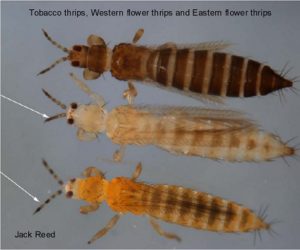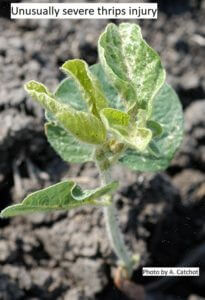 Several kinds of thrips may be observed feeding on soybean. Common examples include tobacco thrips and soybean thrips. Thrips are small, slender insects. Adults are about 1.5 – 2.0 mm long and can usually be distinguished from the immatures by the presence of two pairs of wings that are held folded behind the back. Each wing is characterized by a fringe of hairs on the posterior margin, but this is not visible except under magnification. Some adults may be wingless. Depending upon the species, adult color varies from yellowish to black. Eggs are very small and are inserted into the host plant. Immature thrips found in soybeans are pale yellow to straw colored. Both immature and adult stages have modified, piercing-sucking mouthparts and feed on plant juices from the wounds made by their “beak.”
Several kinds of thrips may be observed feeding on soybean. Common examples include tobacco thrips and soybean thrips. Thrips are small, slender insects. Adults are about 1.5 – 2.0 mm long and can usually be distinguished from the immatures by the presence of two pairs of wings that are held folded behind the back. Each wing is characterized by a fringe of hairs on the posterior margin, but this is not visible except under magnification. Some adults may be wingless. Depending upon the species, adult color varies from yellowish to black. Eggs are very small and are inserted into the host plant. Immature thrips found in soybeans are pale yellow to straw colored. Both immature and adult stages have modified, piercing-sucking mouthparts and feed on plant juices from the wounds made by their “beak.”
Thrips are very common insects found in soybean but rarely justify an insecticide treatment because soybean plants are tolerant to injury. Economic damage to soybeans is only likely during the seedling stage when environmental conditions result in poor seedling growth and low vigor. Feeding often causes yellow or white speckling on leaves, particularly around leaf veins, and a general stunting of plants. Leaves may be somewhat crinkled or cupped when thrips populations are high, and in rare cases, plants may be killed. For more information visit the Soybean Insects Thrips Fact Sheet (W202).
Vigorously thumping seedling plants over a white surface or into a white container is sometimes done as a means of counting thrips. Visual observations of plant injury, such as leaf speckling, is also a sign of thrips infestation.
Treatment for thrips is not recommended except in rare cases when serious injury such as plant death or extreme stunting is observed. Treatment should not be made once plants have two or more trifoliate leaves.
Insecticide seed treatments such as Cruiser, Gaucho, and NipsIt Inside provide some protection during the seedling stage, but poor control may be observed because of insecticide resistance in populations of tobacco thrips.
Management options
Acephate products, such as Orthene, at a rate of 0.2 – 0.33 lb active ingredient per acre can be used to control infestations of thrips. Pyrethroid insecticides are not recommended.
- For more information see http://utcrops.com/soybean/soybean_insects/SoybeanThrips.htm.

